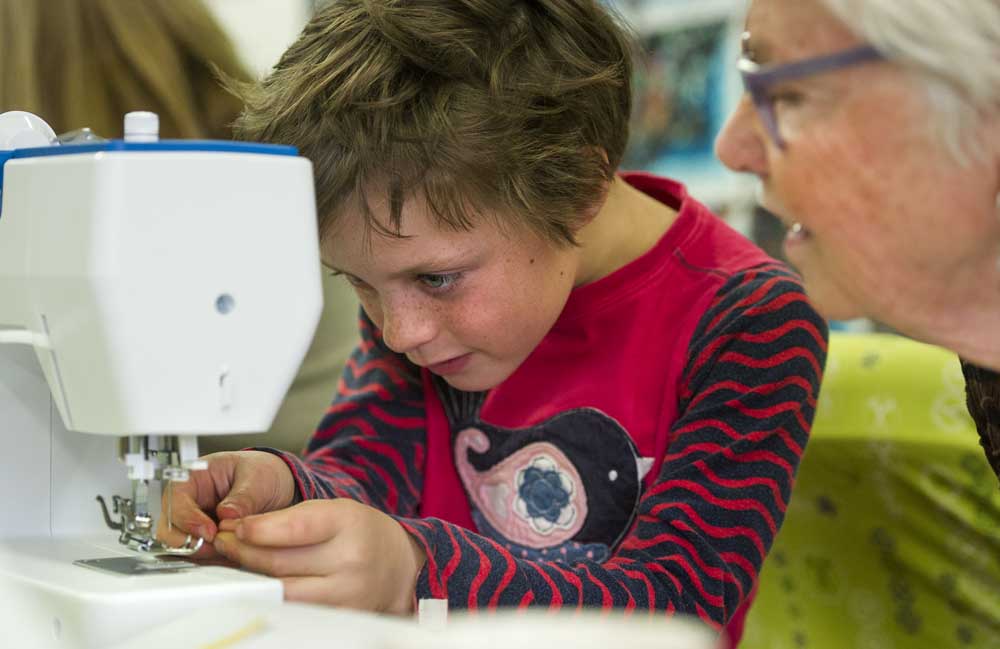‘Sewing’ a love of needle and thread
Published 12:00 am Saturday, November 24, 2018

- Eight-year-old Abby Gilbert threads the needle on a sewing machine as her mentor Carol Knowles watches during a Sew Teach Me class at QuiltWorks in Bend on Wednesday, Nov. 14, 2018. (Ryan Brennecke/Bulletin photo)
Alexis McCoy, 9, sat in front of a whirring sewing machine. She was busy making a pillowcase. Perhaps too quickly.
“I pricked my finger again!” she said, grinning. She held up two fingers displaying small bandages from run-ins with pins.
That her grandmother taught her the basics to a sewing machine may explain why she was zipping through her second lesson at the Sew Teach Me, a Bend nonprofit program that teaches children to sew at QuiltWorks, a fabric store.
“Be careful of those pins,” said June Krol, Alexis’ sewing mentor, who sat at her side.
Alexis, a fourth-grader at Westside Village Magnet School, has sewn by hand and by machine since she was age 4, she said. By the end of the session, which can range from one to two hours, Alexis finished a pillowcase using a sewing technique Krol taught her to hides the stitches. In subsequent lessons, Alexis and other students will make a sewing tool caddy, similar to a knife roll used by chefs to store cutlery, and a stuffed animal “pillow pet.” Alexis and a couple of the children seated at sewing machines wore felt nametags around their necks, which was their first project.
“I enjoy sewing, but I don’t have the patience,” Alexis said. Her abilities indicate otherwise. Transfixed, Alexis fed fabric beneath the humming needle, whose speed she adjusted with a foot pedal.
“Take it slowly. Don’t rush it,” Krol said. “We don’t want any more Band-Aids on your fingers.”
Alexis is the 101st child to benefit from the Sew Teach Me program at QuiltWorks, a Bend fabric store owned by Marilyn Forestell, who relaunched Sew Teach Me in April 2017. Girls and boys ranging in age from 8 to 18 are taught by a mentor how to sew by hand and machine. The free program is kept humming by donations and by the screened mentors who volunteer their time and cover some expenses. Another dozen children have received lessons in the Sew Teach Me chapters that have sprung up in Washington, Pennsylvania and other locations in Oregon, such as Sunriver. About half of Sew Teach Me students further their sewing skills through more advanced programs called Sew Teach Me Two and Three, the latter of which is student directed.
Alexis’ familiarity with a sewing machine is exceptional. Most students are starting from scratch, Krol said.
Chad Snippen, 8, sat across a broad table from Alexis. He was putting the finishing touches on a tool caddy that can store a book and writing utensils. Chad was also interested in using sewing to create and fix things.
“A lot of things rip at my house,” Snippen said. “Like my brother’s shirt. He thought (his sleeve) had a thumb (hole), but it was actually a hole in the shirt. When he put his thumb in it, it ripped.”
Chad’s grandmother, Janet Snippen, stood nearby. She had recommended that Chad take sewing lessons. Even though he’s already busy with soccer, football and violin practices, Chad was interested. “He thought it was a great idea,” Janet said. “He’s the kind of kid who loves to do anything and everything.”
Chad wants to work on sewing projects without having to ask his grandma to do all the work. As for the fourth Sew Teach Me project, Chad has begun work on a pillow pet in the shape of a rabbit. The third-grader at William E. Miller Elementary School hopes someday to make a robe for himself.
Lifelong learning
QuiltWorks first offered sewing lessons to children, as it continues to offer to adults, when Forestell opened the store in 2010. That lasted five years until Forestell put the lessons on hold. Several aspects didn’t work: Children were required to bring their own sewing machines (which ranged in reliability), supplies, design their own projects and pay a $75 fee. A volunteer instructor was responsible for as many as eight children, any one of whom ground the lesson to a halt when they encountered a problem and needed individual attention.
“It was very stressful,” Forestell said. “But every (customer) who came into the store loved it.”
Some customers would tell Forestell how the scene of children busy with sewing tasks reminded them of when they were taught to sew by a grandmother, mother or by a home economics teacher or at a 4-H Club.
This enthusiasm kept Forestell determined to revamp the program instead of abandoning it. During a week off — the first in seven years, Forestell said — she found a way to reconfigure the sewing lessons. This time around, a child would be matched with a trained mentor for quality one-on-one — or, at the most, one-on-two instruction. The sewing machines would be provided. She would ask the sewing community to donate fabric and supplies. There are about 28 mentors, some of whom are active year-round. A mentor spends about 10 to 12 hours with a child, Forestell said. About half of the children want to further their sewing beyond Sew Teach Me.
“Sewing gives children a chance to be creative, to be productive, to make a mistake and to learn how to fix it and not be affecting anybody else,” Forestell said. “And it helps them develop confidence. Sewing is a skill they will have for the rest of their lives.”
Forestell marvels at how seamless and seemingly self-operating Sew Teach Me now is. She intends to promote the program to other quilt shops throughout the Pacific Northwest.
“Today, children are so plugged into their devices,” Forestell said. “The funny thing is 101 kids, by most people’s account, is great. In my mind, we should be at number 200. But it is fantastic to have 101 kids. … My generation, the baby boomers, have so many skills to share.”
Abby Gilbert, 8, sat with mentor Carol Knowles, a home economics teacher who retired from Cascade Middle School.
“You’re doing better than my sixth-, seventh- and eighth-graders,” Knowles told Abby, a second-grader at Silver Rail Elementary School. Abby was in her first lesson in which Knowles showed Abby how to train the thrumming needle on a circle she drew on a piece of fabric.
“You’re really good at sewing slow,” Knowles said. “If you start to get off the line, just take your foot off (the pedal), take a deep breath and start over. You can’t just lift the needle and move the fabric because then you’ll have a big loop of thread that will knot.”
For Abby, learning to sew has been a longtime goal.
“I’ve wanted to sew my kitty, Jasper, a little vest,” Abby said. “And blankets. Lots of them.”
— Reporter: 541-617-7816, pmadsen@bendbulletin.com








